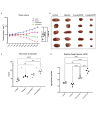The ability of clostridium novyi-NT spores to induce apoptosis via the mitochondrial pathway in mice with HPV-positive cervical cancer tumors derived from the TC-1 cell line
- PMID: 39732669
- PMCID: PMC11682659
- DOI: 10.1186/s12906-024-04742-5
The ability of clostridium novyi-NT spores to induce apoptosis via the mitochondrial pathway in mice with HPV-positive cervical cancer tumors derived from the TC-1 cell line
Abstract
Background: A precise observation is that the cervix's solid tumors possess hypoxic regions where the oxygen concentration drops below 1.5%. Hypoxia negatively impacts the host's immune system and significantly diminishes the effectiveness of several treatments, including radiotherapy and chemotherapy. Utilizing oncolytic spores of Clostridium novyi-NT to target the hypoxic regions of solid tumors has emerged as a noteworthy treatment strategy.
Methods: The transplantation procedure involved injecting TC-1 cells, capable of expressing HPV-16 E6/7 oncoproteins, into the subcutaneous layer of 6-8-week-old female C57/BL6 mice. The TC-1 cell line, was subcutaneously transplanted into 6-8-week-old female C57/BL6 mice. The tumor-bearing mice were randomly divided into 4 groups, and after selecting the control group, they were treated with different methods. Group 1- control without treatment (0.1 ml sterile PBS intratumor) Group 2- received cisplatin intraperitoneally (10 mg/kg) Group 3- received 107Clostridium novyi-NT spores systemically through the tail vein Group 4-tumor mice received 107Clostridium novyi-NT spores intratumorally. 20 days after the start of treatment, the mice were sacrificed and tumor tissues were isolated. In order to clarify the mechanism of the therapeutic effect with spores, the amount of ROS and ceramide was measured by ELISA technique, and the expression level of cytochrome c, cleaved caspase- 3, Bax, Bcl-2, HIF-1α, and VEGF proteins was measured by western blotting.
Results: Our results clearly showed that the injection of Clostridium novyi-NT spores (either intratumorally or intravenously) causes the regression of mouse cervical tumors. Spore germination induces internal apoptosis in cancer cells by inducing ROS production and increasing total cell ceramide, releasing cytochrome c and damaging mitochondria. Additionally, the results provided clear evidence of a significant decrease in the expression of HIF-1 alpha and VEGF proteins among the tumor groups that received spores, when compared to both the cisplatin-treated group and the control group.
Conclusions: The study's outcomes demonstrated that the introduction of Clostridium novyi-NT spores triggered apoptosis in cervical cancer cells (derived from the TC-1 cell line) via the mitochondrial pathway, subsequently resulting in tumor regression in a mouse model.
Keywords: Clostridium novyi-NT; Apoptosis; HPV-positive cervical; Oncolytic bacteria; TC-1 cell line.
© 2024. The Author(s).
Conflict of interest statement
Declarations. Ethics approval and consent to participate: This study was reviewed and approved by the Research and Technology Vice-Chancellor of Tabriz University of Medical Sciences (IR.TBZMED.VCR.REC.1398.434). This vice-chancellor has an ethics committee that fully supervises all the ethical aspects of the conducted research (including ethical discussions of working with laboratory animals and ethics in publishing research) with the help of a grant from Tabriz University of Medical Sciences. Additionally, all animal work was performed under the standards of the Iran National Committee for Ethics in Biomedical. All animal experiments comply with the ARRIVE guidelines and carried out in accordance with the U.K. Animals (Scientific Procedures) Act, 1986 and associated guidelines, EU Directive 2010/63/EU for animal experiments. Consent for publication: Not applicable. Competing interests: The authors declare no competing interests.
Figures



Similar articles
-
Anti-tumor Effects of Cisplatin Synergist in Combined Treatment with Clostridium novyi-NT Spores Against Hypoxic Microenvironments in a Mouse Model of Cervical Cancer Caused by TC-1 Cell Line.Adv Pharm Bull. 2023 Nov;13(4):817-826. doi: 10.34172/apb.2023.084. Epub 2023 May 20. Adv Pharm Bull. 2023. PMID: 38022809 Free PMC article.
-
Therapeutic Potential of Clostridium novyi-NT in Cancer: Current Knowledge and Future Perspectives.Curr Cancer Drug Targets. 2023;23(9):682-696. doi: 10.2174/1568009623666230413094253. Curr Cancer Drug Targets. 2023. PMID: 37069721 Review.
-
Intratumoral Injection of Clostridium novyi-NT Spores in Patients with Treatment-refractory Advanced Solid Tumors.Clin Cancer Res. 2021 Jan 1;27(1):96-106. doi: 10.1158/1078-0432.CCR-20-2065. Epub 2020 Oct 12. Clin Cancer Res. 2021. PMID: 33046513 Clinical Trial.
-
Learning from Clostridium novyi-NT: How to defeat cancer.J Cancer Res Ther. 2018;14(Supplement):S1-S6. doi: 10.4103/0973-1482.204841. J Cancer Res Ther. 2018. PMID: 29578142 Review.
-
Evaluation of Clostridium novyi-NT spores in dogs with naturally occurring tumors.Am J Vet Res. 2012 Jan;73(1):112-8. doi: 10.2460/ajvr.73.1.112. Am J Vet Res. 2012. PMID: 22204296 Free PMC article.
References
-
- Datta A, West C, O’Connor JP, Choudhury A, Hoskin P. Impact of hypoxia on cervical cancer outcomes. Int J Gynecologic Cancer. 2021;31(11). - PubMed
MeSH terms
LinkOut - more resources
Full Text Sources
Medical
Research Materials

